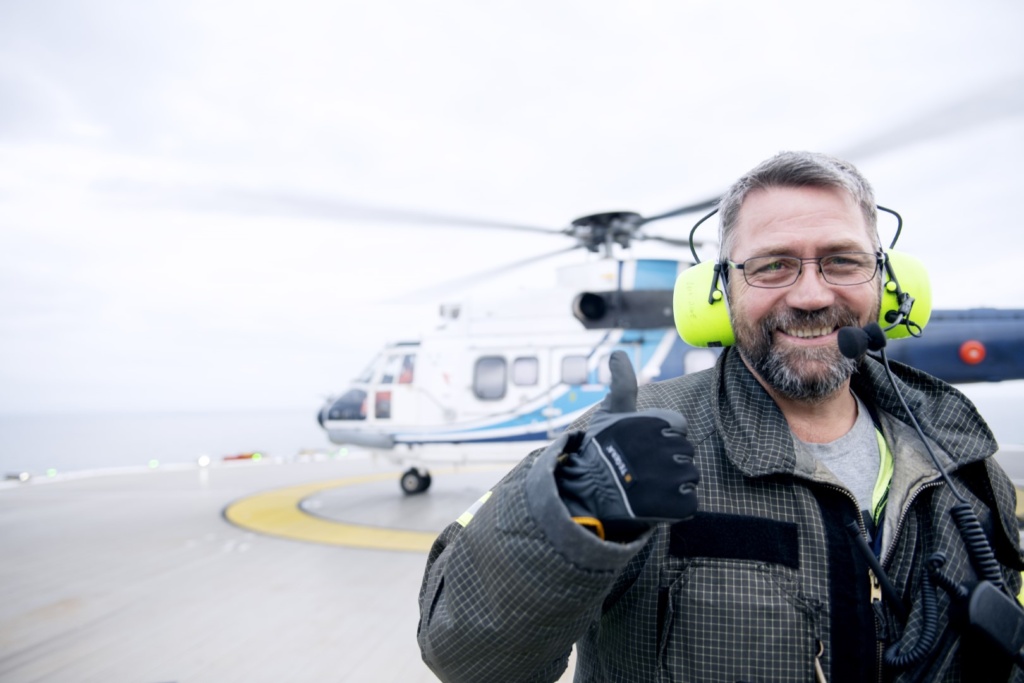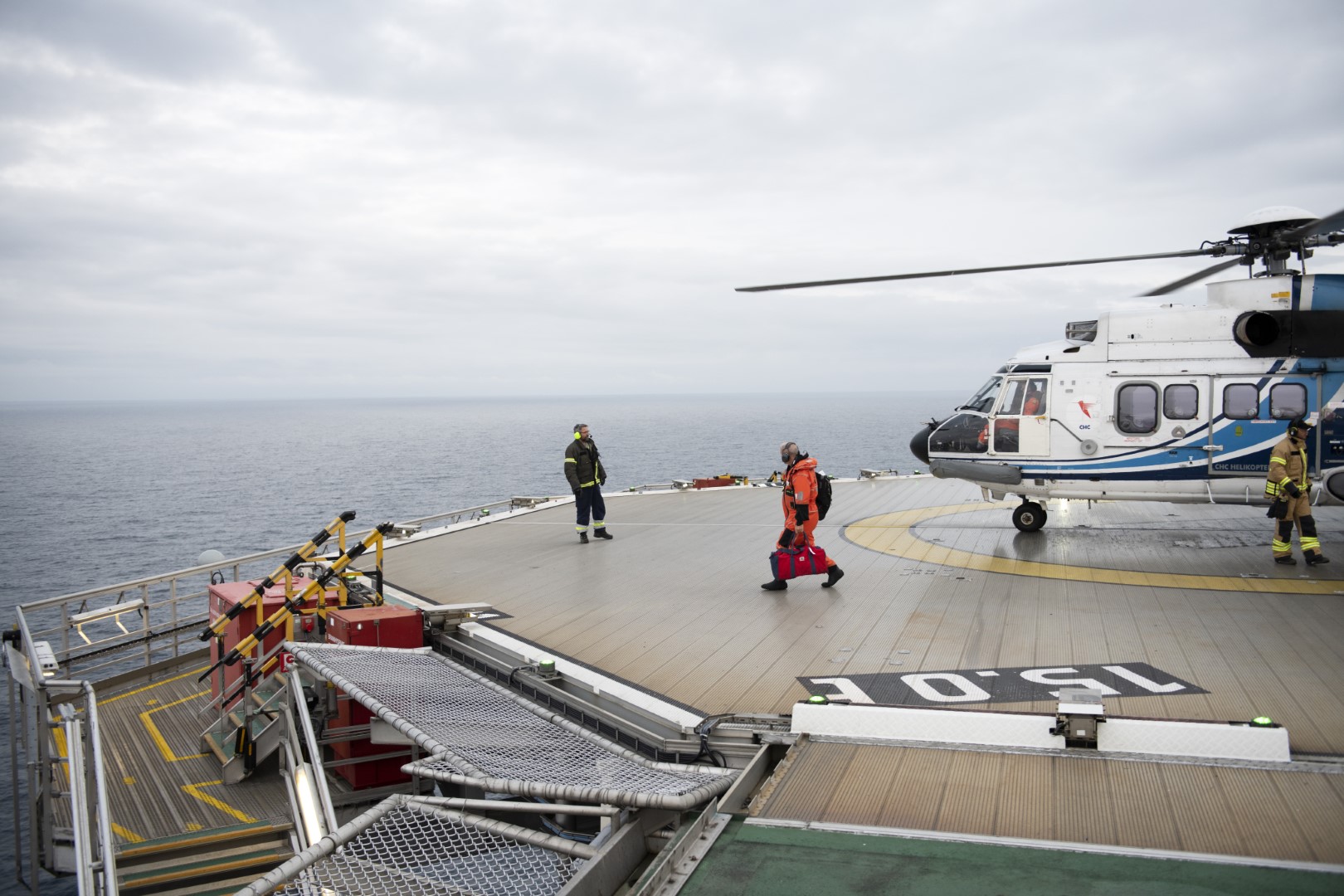Traveling offshore
Before you travel offshore, here are the information you need to familiarise yourself with.
Health certificate and course diploma
Make sure your offshore health certificate is valid and take it with you. The certificate is valid for two years. Aker BP employees can get the health examination by contacting Aker BP’s Health Department. You must be prepared to show your certificate upon check-in at the heliport.
Identification
Bring valid identification: passport, drivers license or national ID-card. Do not pack these documents in the checked-in luggage as you have to identify yourself at the security check before boarding.
If you are a foreign citizen, you must have a valid residence permit and work permit and be able to show these at check-in.
Requirements before departure
General requirements before departure to Aker BP’s fixed installations:
- Valid offshore health certificate
- Basic safety course (GSK)
- Mandatory for all offshore personnel
- Rehearsal course every four years
- Distinct non-offshore personnel (VIP, media, etc.) without GSK training must as a minimum complete dedicated helicopter underwater escape including airpocket and EBS short course
- AT / SJA
- Interactive course that is mandatory for all offshore personnel
- Includes common procedures for work permits (AT) and safe job analysis (SJA)
- Completed the e-learning course «A SAFER departure training». The course is available via Aker BP’s Training Portal. Choose the training module that matches your dicipline. If you are unsure, select “Operation and maintenance”.
- Operation and maintenance
- Project and modifications
- Drilling and well maintenance
- Insulation, scaffolding and surface (ISO subjects)
- Catering
For technical support and technical issues, please contact: support@mintragroup.com. Please note that there may be specific departure requirements for drilling rigs or flotels that are commissioned by Aker BP.
Departure documents such as health certificate and course certificate should be uploaded to www.MinDawinci.no. These must also be able to be displayed on request at the heliport. Are you having issues with uploading the documents? Contact aviation@akerbp.com.
My DaWinci profile
It is expected that you create a My DaWinci profile. This is an online portal for anyone traveling offshore, where you get an overview of your personal data, certificates and completed courses. The portal is used for pre-check-in for helicopter tours. Through your profile, you can also e.g. subscribe to your departure information, expiry date of own departure requirements and other useful information.
On departure, you are expected to do a pre-check-in (including approval of the privacy statement) via your My DaWinci profile, so that you can use the self-service check-in machine at the Heliport.
Meeting point
You must meet at the heliport no later than one hour before departure. For first-time travelers, it is recommended to come even earlier. Change of departure time must be clarified and approved in advance. Helicopter departures can be followed at heliport.no

Luggage
Your luggage must comply with the following requirements:
- Maximum weight per bag: 10 kg
- Maximum size: 60 x 50 x 30 cm
- Maximum 2 bags – exceeding luggage must be sent as cargo
- Avoid using bags that can be caught by the wind on the helideck
It is not allowed to bring hand luggage on board the helicopter except a newspaper or book that can be placed in the inner pocket of your survival suit.
Tools and equipment can not be checked in as luggage. This must be sent as cargo. There are separate guidelines for: Offshore Norway. 003 Recommended guidelines for safety control at the helicopter terminals
Protective equipment
The BMS procedure (81-000702) for the selection and use of personal protective equipment required to travel offshore for AkerBP must be followed.
Standard personal protective equipment must be used when outside the living quarters.
The following personal protective equipment is defined as standard at Aker BP:
- Overalls with long sleeves and reflective stripes.
- Helmet with fitted hearing protection, ratchet Suspension or chin strap.
- Protective footwear, ankle boots (or higher) with lacing / BOA lacing system to ensure adequate ankle support.
- Safety glasses or CE approved personal glasses with side protection.
- Protective gloves with cut and impact protection.
Medicines
All medicines must be registered at the heliport and presented at the security check.
- Non-prescription drugs can only be included in unopened packaging.
- Prescription medicines must be in the original packaging and marked with your name (prescription label).
- All medications must be cleared with the medic onboard on arrival offshore.
- Remember to bring enough medication for the entire trip. Take into account the possibility of a delayed return.
For more details: Offshore Norway, 003 Recommended guidelines for safety control at the helicopter terminals.
Personal electronic equipment (PC, mobile, camera, tablet and smartwatch)
- It is not permitted to use a mobile phone, tablet, or laptop during the helicopter flight. The devices must be completely switched off (not flight mode) and packed in the luggage. Mobile phone can be placed inside your survival suit.
- During the safety film, both onshore and offshore, the mobile phone must be completely switched off and placed in the inner pocket of your suit.
- Smartwatches must also be fully switched off during the helicopter flight.
- Use of mobile phones and electronic equipment is limited to approved areas of the living quarter and is not permitted in the production areas.
- Those who travel offshore must obtain the approval by the platform manager for use of mobile phones in offices and control rooms.
- Mobile phones that are switched on must always be set to silent. Talking on mobile phone should, generally, take place in cabins or places where you are not disturbing others.
- Work permit must be obtained in advance of photography/filming outside the living quarter/approved area.
- It is not permitted to use personal electronic devices in an emergency situation.
- It is not permitted to post information, photo or video on social media, or through other channels, during or after an emergency.
- In potentially explosive atmospheres, smartwatches and other personal electronic equipment are not permitted.
- It is not permitted to bring batteries and powerbanks offshore.
For more details: SFS, Use of personal electronic devices.
Other
It is forbidden to bring alcohol, weapons and other objects, such as a knife, pepper spray or similar, that may pose a danger to personnel and equipment.
The facilities
Before traveling offshore, you should familiarise yourself with our assets.
Helicopter flights in Arctic regions
Special requirements for the use of woolen underwear apply to helicopter flights to and from rigs, vessels or installations in Arctic waters (Barents Sea). You will receive detailed information based on location and season.
HSE portal (in Norwegian)
If you want to read more about our HSE work, please visit our HSE portal (in Norwegian).
